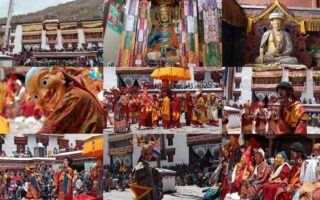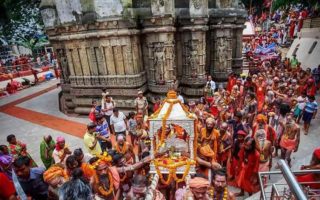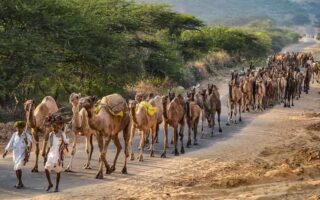At a Glance:

Each of the three Bihu festivals is linked to different periods in the agricultural calendar. Magh Bihu marks the end of the harvesting period, Bohag Bihu celebrates the start of the New Year, and Kati Bihu is associated with transplanting and sowing rice paddy. Magh Bihu is also known as Bhogali Bihu, Bohag Bihu is called Rongali Bihu, and Kati Bihu is known as Kongaali Bihu.
The Sonowal community in Assam also celebrates Rongali Bihu as its traditional festival. The most prominent aspect of Bihu is the dance, in which young boys and girls form two groups and perform energetic dances to the beats of pipes and drums. During the Bihu festival, folk women clean their homes and clothes, and they prepare traditional Bihu delicacies such as Pitha and Chira. Folk men are busy gathering items like Tara Pogha (cattle ropes), which are used to make vegetable offerings, including Brinjal, raw turmeric, and gourds. The preparation of Goru Bihu (cattle celebration) for the next day is also an important part of the tradition.
The first day of Bihu is dedicated to cattle, including bullocks and cows. According to tradition, on this day, the animals are bathed in river water in the early morning. People also prepare special vegetable dishes for the cattle. Later in the day, animals are tied with Tara Pogha, and people offer them special cakes. On this day, both boys and girls wear new clothes and enjoy the unique offerings of Bihu. There are also competitions like egg fights, and participants sing romantic and love songs. This type of gathering is known as Mukoli Bihu. The Bihu songs, also called Bihu Geets, are popular throughout the region. On another day of the festival, Bihu Husori and Manuh Bihu are introduced at the Namghar, a community prayer hall.
Bohag Bihu or Rongali Bihu
This is one of the three Bihu festivals and is non-religious and secular in nature. Rongali Bihu symbolizes the arrival of the spring season and is a festival filled with joy and celebration. For the Sonowal community, Rongali Bihu is a major festival, celebrated on Sankranti (also known as Chot) on the 14th of April. The festivities continue for two weeks.
Magh Bihu or Bhogali Bihu
Magh Bihu, also known as Bhogali Bihu, derives its name from the word “Bhoga,” meaning enjoyment or feasting. It marks the end of the harvesting season and the excitement for the upcoming days. As a harvest festival, the eve of Bihu is called Uruka. The last day of the festival is called Puh, during which women of the community prepare rice cakes and other delicacies. A central tradition of Uruka is the construction of the Meji, a large structure resembling a temple made of firewood, and the Bhelaghar, a makeshift hut.
The entire night of Uruka is celebrated with singing, feasting, and dancing. On the first day of Magh Bihu, people gather in the early morning to light a fire at the Bhelaghar and Meji, offering rice, sesame, and other foods to the fire (Agni). After the Meji and Bhelaghar are burnt, people sit and sing Naam Kirtana. On this day, the people abstain from eating rice and curry, instead enjoying Pitha, Chira, curd, and a special dish called WahKarai, which is a mixture of black gram, rice, ginger, and sesame cooked in oil.
Kati Bihu or Kongaali Bihu
Kati Bihu, also known as Kongaali Bihu, takes place when the paddy seedlings are growing. During the evening, people offer prayers at the Tulsi plant in their courtyards and light small lamps around the plant. Additionally, rituals are performed to enhance crop growth. The significance of Kati Bihu is most noticeable in rural areas, where farmers light up the sky with Akash Banti (sky lamps) made from large bamboo poles to protect their fields from insects and pests.
- Also Read: Fair and Festivals of Assam


